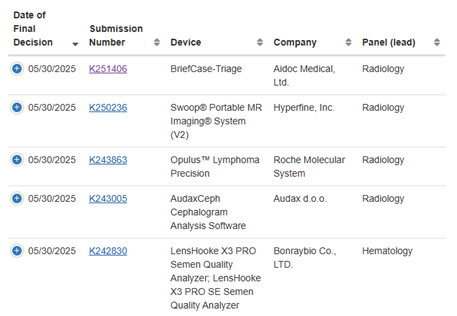AI-Enabled Medical Devices Here To Stay?
ABSTRACT: This summer, FDA published a list of AI-Enabled Medical Devices as a resource to quickly identify AI-enabled medical devices authorized for marketing in the United States. As of September 30th, FDA is also seeking public comment on measuring and evaluating the performance of AI-enabled medical devices in the real-world. Will healthcare innovators, providers and/or patients begin using these devices more than non-AI-enabled medical devices? Will public comment help shape how FDA regulates and/or approves these devices? Time will tell, but as with other areas of AI, we anticipate exciting developments are on the horizon for medical devices.
This summer, FDA published an updated list of Artificial Intelligence (AI)-Enabled Medical Devices as a resource to quickly identify AI-enabled medical devices authorized for marketing in the United States. As a reminder, AI is “[a] machine-based system that can, for a given set of human-defined objectives, make predictions, recommendations, or decisions influencing real or virtual environments.” AI systems use “machine- and human-based inputs to perceive real and virtual environments; abstract such perceptions into models through analysis in an automated manner; and use model inference to formulate options for information or action.”
At this time, there appears to be approximately 1,247 AI-enabled medical devices listed for ease of reference to healthcare innovators, providers, and patients from many different companies and many different areas of medicine. No need to scroll through all of them though – there’s a search function and the categories of information can be adjusted/filtered. It is explicitly noted, however, that the list is not a comprehensive list, but rather were identified “primarily based on the use of AI-related terms in the summary descriptions of their marketing authorization document and/or the device’s classification.”
Going through the entries you can click on the AI-medical device’s submission number which will lead you to a page with more information about the device. For example, the submission number may lead you to a page concerning a device’s 510(k) Premarket Notification. Briefly, 510(k) clearance is the FDA’s process for approving a medical device for marketing within the United States after a manufacturer demonstrates that the device is substantially equivalent to a legally marketed device (“predicate device”) and it not subject to Premarket Approval (PMA).
Once there, you can click on “Summary” for the detailed correspondence between the FDA and the entity seeking 510(k) approval for the device, which will also include the devices “indication for use,” which outlines what the device is intended to be used for (below is an image of a portion of the list for reference). If there are any recalls and/or other changes to the approval and/or indication for use, it appears that you can also view that information if applicable/available.

Will healthcare innovators, providers, and/or patients begin using these devices more than non-AI-enabled medical devices? Will this list help promote the creation of more AI-enabled medical devices to serve other medical needs? Time will tell, but the current list appears to be a good tool in assisting with research the use and application of AI and medical device technology.
As of September 30th, FDA is also seeking public comment on the “current, practical approaches to measuring and evaluating the performance of AI-enabled medical devices in the real-world, including strategies for identifying and managing performance drift, such as detecting changes in input and output.” Of course, FDA is focused on ensuring that these AI-devices are safe and effective through the product’s life cycle. Categories FDA is seeking comment on include 1) Performance metrics and indicators (e.g. metrics to measure safety, effectiveness, and reliability of the devices), 2) Real-world evaluation methods and infrastructure (e.g. tools to monitor the devices’ performance post-deployment), 3) Postmarket data sources and quality management (e.g. data sources used for ongoing performance evaluations), 4) Monitoring triggers and response protocols (e.g. triggers requiring more intensive evaluation), and 5) Human A-I interactions and user experience (e.g. design features most effective for maintaining safe and effective use).
The comment period is open until December 1, 2025. It is not currently clear how FDA will utilize comments, but questions have been raised as to whether FDA will try to impose additional pre-market requirements or even impose post-market requirements on currently marketed AI-enabled devices that had already been authorized. We will be keeping an eye on developments arising from this open comment period.
related services

Evasive Jurisdiction: Site Unseen ...

Cybersecurity Check-Up: Always A Good Time To Prepare to Protect ...
About Drug / Device Law Blog
Baker Sterchi's Drug / Device Law Blog examines topics and legal developments of interest to the drug and device industry. Learn more about the editor, Paul Penticuff, and our Drug and Device practice.
Subscribe via email
Subscribe to rss feeds
RSS FeedsABOUT baker sterchi blogs
Baker Sterchi Cowden & Rice LLC (Baker Sterchi) publishes this website as a service to our clients, colleagues and others, for informational purposes only. These materials are not intended to create an attorney-client relationship, and are not a substitute for sound legal advice. You should not base any action or lack of action on any information included in our website, without first seeking appropriate legal or other professional advice. If you contact us through our website or via email, no attorney-client relationship is created, and no confidential information should be transmitted. Communication with Baker Sterchi by e-mail or other transmissions over the Internet may not be secure, and you should not send confidential electronic messages that are not adequately encrypted.
The hiring of an attorney is an important decision, which should not be based solely on information appearing on our website. To the extent our website has provided links to other Internet resources, those links are not under our control, and we are not responsible for their content. We do our best to provide you current, accurate information; however, we cannot guarantee that this information is the most current, correct or complete. In addition, you should not take this information as a promise or indication of future results.
Disclaimer
The Drug / Device Law Blog is made available by Baker Sterchi Cowden & Rice LLC for educational purposes only as well as to give you general information and a general understanding of the law, not to provide specific legal advice. Your use of this blog site alone creates no attorney client relationship between you and the firm.
Confidential information
Do not include confidential information in comments or other feedback or messages related to the Drug / Device Law Blog, as these are neither confidential nor secure methods of communicating with attorneys. The Drug / Device Law Blog should not be used as a substitute for competent legal advice from a licensed professional attorney in your state.














